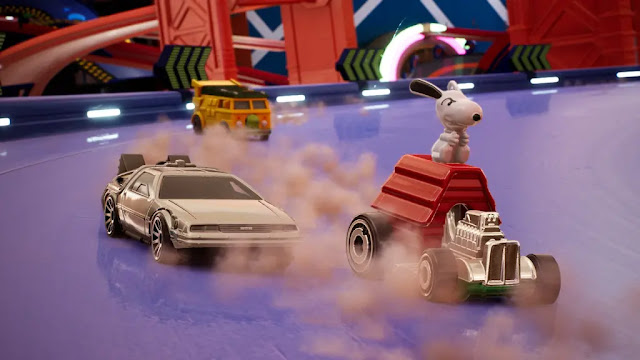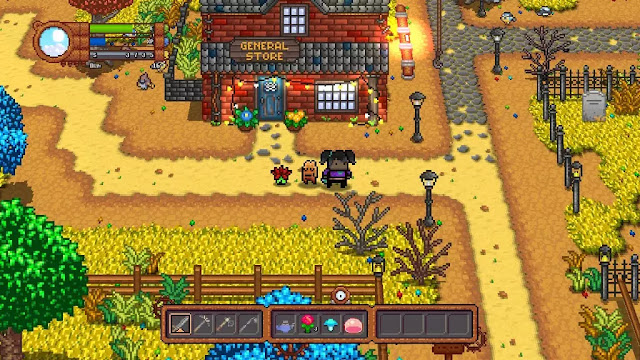Hot Wheels Unleashed by developer and
publisher Milestone
S.r.l.—Sony PlayStation 5 review written by Nick
with a copy provided by the publisher.
Estimated reading time: 7 minutes
Hot Wheels Unleashed was one of those titles that caught my eye when it was first announced, which has the potential to disappoint if it didn’t meet my expectations. The good news? It exceeded them. Hot Wheels Unleashed is a fantastic arcade racer with plenty of staying power.
First and foremost – it’s the aesthetic for me. Having been born in the 70’s, playing with toy cars in a variety of bigger-than-life racetracks predates my love of video games, Hot Wheels Unleashed tickled my nostalgia in a unique way. Instead of blocky, retro graphics doing the trick, the visuals are instead bringing my childhood memories into sharp focus. For starters, there is a massive collection of cars here, and they get presented with fantastic, detailed models. Before you acquire them, they sit in their traditional cardboard backed, plastic-covered packaging that you used to see in the stores when they were hanging on wire racks in the toy department. It’s a simple aesthetic before opening one, but still pretty cool.
However, it’s the variety and design that takes center stage here. You have traditional cars, but you have plenty of other IPs in there as well, from Snoopy on top of a car or Batman represented. This sets the developer up with an opportunity to release plenty of DLC here as well, going forward. This is more than just visual flare however, as the cars have the specific stats we have come to expect from racing games. Acceleration, top-end speed and handling vary from car to car. One interesting twist is the boost meter, which can handle a bit different from one type of car to the next as well, from smaller, compartmentalized boosts to longer, single thrust slingshots that send you rocketing past the competition.
This ties into the two different kinds of resources in the game. One is coins, which is simple enough – you use it to buy blind packs or from a pool of rotating cars that you can purchase directly. This kind of blind pack system could be frustrating at first glance, because there’s no duplication protection and the first time I drew a duplicate I sighed. Then I quickly discovered I could sell the duplicate and it was just about the same price as a new blind pack, so I jumped right in and pulled something new moments later. The other resource are parts / gears that go into upgrading your cars. You can take a common car and upgrade it to a rare one and further upgrade it again if you save up enough parts. Early on, I had one that I liked well enough to invest in and get really good with, but the more I played Hot Wheels Unleashed, the more cars I unlocked and the more I found myself upgrading multiple vehicles to see how they turn out and play compared to one another.
All of this works only because the core gameplay is so tight. I was surprised to find I was not terribly good at Hot Wheels Unleashed initially. Not because I’m great at racing games – I’m really not. But I got my tail kicked in the tutorial, which is not how that usually goes. There are different difficulty settings, which was a big help to me early on as I learned the nuances of the controls. There’s little things, like how drifting into corners can help more rapidly replenish your boost, that you need to learn to take advantage of in order to come out on top. Track familiarity is helpful as well. First time through there was almost always one little thing that would surprise me, such as a key jump or a sliding turn that took me off of the path just a bit more than expected, that I had to learn. Additionally, the difficulty only really impacts the opposing cars, which is great in the races / nodes / objectives that have you going up against nearly a dozen opponents – but it doesn’t help a lick if your racing skills aren’t quite up to snuff and you are struggling with time attack nodes in the campaign.
The track design is arguably the best element of the game, but it kind of ties into my above statement about needing to learn the tracks. It’s one thing to see the track layout in the corner of the screen, similar to most racing games. But there’s a few extra elements that you can’t always anticipate for by looking at that, and often times these are involving sharp turns which doesn’t give you a lot of visual warning either. If you don’t make a jump going fast enough, you’ll miss the landing point on the other side of the gap and have to reset your car. There may be a section where you’re on a brown wooden floor with orange cones coming up that don’t really stand out much until you’re right on them and already turning – leading you to stray from the track. These little quirks are sometimes annoying in what is otherwise pretty fun track designs. They make use of a combination of things, such as magnetic tracks that allow you to go vertical or through large loops like the old school tracks of my youth, but also span tabletops, have household items as part of the visual environment that just add a bit of flare to everything.
Aside from getting new cars, you can also unlock new items in the area called the Basement. This is one of a half dozen other zones (such as a skate park or a garage), but the basement is probably the coolest for two reasons. One, it’s the most like my childhood in terms of nostalgia. Additionally, you can edit the basement, adding things like different items for the shelf, different colors and patterns on the walls, ceilings and floors, things like that. You don’t get to make any changes to the actual race course, but it’s still a neat feature that I’d love to see added to the other locales later. Also, given the action’s intensity? I found it difficult to take in the environments unless I was having someone else race and I was spectating. It’s dangerous to let your eyes drift off of the track for too long. In terms of the camera view, I could see this being an issue for some people as well. I prefer the angle used here – behind the car is my default in pretty much all racing games. But I can see some people feeling it’s a missed opportunity to see the dash or even take on the action from a first-person perspective not offered here.
Last but not least, there’s several modes here to keep you coming back for more. You can do quick races, online matches and the other normal modes – but there’s a bit of a more involved campaign mode that has you doing ‘boss battles’, different kinds of races (timed, competitive position, etc) that unlock nodes on the map with each successive victory. Each victory also tosses you things like gears, coins and blind packs, further adding to your stock of cars. It’s all a very rewarding system of progression, constantly dangling that carrot while the game itself really lends itself to that addictive “Just one more race” mentality. Lastly, for those with a creative itch out there to scratch, the Track Builder mode is pretty robust and you can share them out online, giving Hot Wheels Unleashed the kind of limitless potential that could keep gamers rallied around this game for a long time. Now, you don’t have access to all of the ‘parts’ right away, as you’ll have to earn them – but these are not core components. Just extra bits of flare that can be tacked on later.
Summary
Hot Wheels Unleashed is a fantastic and thoroughly enjoyable arcade racer that brings my childhood imagination to the big screen in thrilling fashion. The visuals are fantastic, there’s plenty of modes and some pretty solid progression elements that kept me coming back for more.
Score: 9 / 10







.jpg)










































